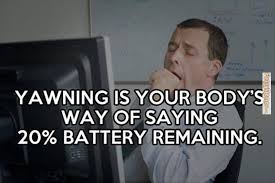Defensive Driving Tip #45:  !
!
As a young guy who absolutely LIVED for vacations, I couldn’t wait to get out of town. I worked the evening shift in an ice cream factory, and my habit was to pack before work, then leave immediately at shift change – stopping at home only to pick up my bride (lucky girl!). We’d drive all night, all next day and stop, exhausted, in mid-evening. After six or eight hours of rest, I’d be ready to hit the road again (early, of course) and put in another long day. We’d repeatedly drive twelve to fifteen hour days for our two weeks of vacation. For me, the driving itself was the point of the trip, but I always had to rest for days when the trip was done! She divorced me, of course.
In Defensive Driving class I teach that collision statistics show fatigue is a major collision factor. We can even identify areas where fatigue collisions commonly occur — usually ten to fifteen hours out from major cities along the interstate highways. It’s fine to be excited about your road trip, and it’s great to plan for an early start, but consider that living to see your next road trip can depend on your staying rested on THIS one. Fatigue limits your coordination and ability to multitask effectively; these are key to your job as a driver, especially at higher speeds.
Smarter Gordon now, who teaches Defensive Driving, plans a day at home before leaving to prepare (and sometimes two). I get sufficient sleep for at least a couple of days ahead of time. I still drive long days, but the driving is punctuated with stops — for food, historical markers (ALL of them — I cannot pass a historical marker), gasoline, sightseeing, etc. When I stop for the day, I stop early enough to relax for awhile, then sleep for eight hours before driving again.
I am prone to drowsiness, especially in the warm morning sun after breakfast. When this happens, I find a shady spot and take a brief nap. Sometimes, even just ten minutes is enough and I am alert again, but more often, it takes twenty to thirty minutes. Don’t keep driving if you begin to get drowsy; you may fall into microsleep without realizing it, and maybe wake up only when your tires drift onto the dirt beside the road. When drivers react suddenly to get back on the road (after falling asleep, for example), they tend to overcorrect and the vehicle is likely to roll over, often ejecting the occupants. This is the one of the most deadly accidents, and the number one type of fatal collision (single vehicle, off the road). As you will learn in Defensive Driving class Wear your seat belts!
Since I have learned my own tendencies (morning drowsiness, for example, or eye fatigue in the evenings), I can take steps to counteract them. I may drink coffee in the morning (before I get drowsy), or stop for the day when I feel my eyes start to get lazy. Remember to take “ten out of two” – every two hours, stop for a ten-minute break. Play games to help prevent highway hypnosis. Keeping your mind active is often an effective preventive. Talk to someone, listen to music you don’t like, or sing loudly along with songs you DO like. Get fresh air, stop and walk around (or take a short nap), and finally, recognize when it is time to stop! Also, look at the tips on the Defensive Driving Page.
Take our Defensive Driving class 2passdd.